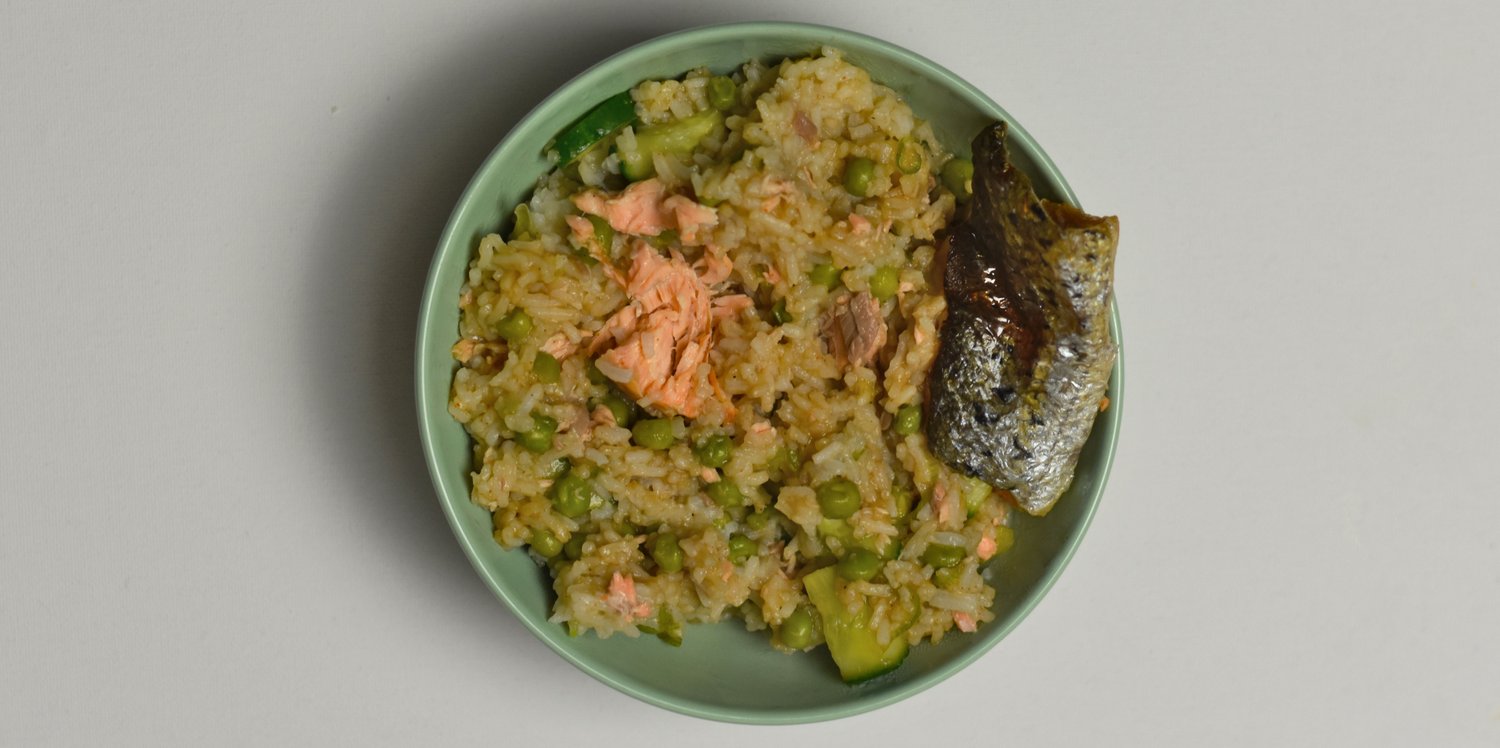How To Make Sushi | Easy Homemade Recipe
Sushi is a delicious treat to have. However, most of us have this impression that it’s something we can’t make at home. I’m here to squish that theory. Although at first, it may be tricky to get the hang of sushi rolling. Following the right steps would make you all the sushi you want and just as delicious as you would get from a £3 Tesco meal deal! If you find yourself asking yourself questions such as “How do I make sushi at home?” or “What's a easy homemade sushi recipe?” then keep on reading.
Homemade sushi roll photo for how to make sushi.
Sushi can be easy to make. Easy, simple homemade sushi is something achievable for any level of home chef. You would be surprised at just how easy it is to make simple homemade sushi.
You will need a few ingredients which will be listed below, everything else is personal preference. That's what makes homemade sushi so delicious! You have full control over how to make your sushi. Tweaking and changing the recipe and fillings to fit your personal sushi roll preferences!
With that being said there are just a few basics of homemade sushi/how to make sushi that we need to cover; The sushi rice, sushi ingredients and equipment needed to make sushi. After that you can fill your sushi rolls with whatever fillings you like.
I’ve included three sushi roll recipes at the bottom of this post which you can use as inspiration. A spicy tuna sushi recipe, A vegetarian sushi recipe and a salmon and avocado sushi recipe.
What is sushi rice
Sushi rice is sold in most Asian shops and supermarkets as well as most large supermarkets such as Tesco and Asda. Which makes it very easy to find. Especially since they are labelled “Sushi rice”
Sushi rice is a short grained, starch filled rice which is similar in its look to risotto rice. However, just because it looks like risotto rice doesn’t mean you can substitute sushi rice for risotto rice. When cooked, sushi rice is extremely sticky. Which makes it perfect for wrapping.
If you were to substitute sushi rice for risotto rice you wouldn’t achieve that level of stickiness in your rice. Meaning your sushi rolls would just fall apart. All your fillings would fall out. Sushi rice holds its form. You can however substitute sushi rice for pudding rice.
easy homemade sushi recipe photo | How to make sushi photo.
How to cook Sushi rice
Cooking sushi rice is relatively easy to do. So easy in fact it takes four steps to cook your sushi rice to perfection.
Step one
Weigh and wash your sushi rice. For this we will use 250 grams of sushi rice. This will give you enough sushi to feed a small family. You need to wash off any excess starch on your sushi. You can do this either adding your sushi to a bowl of cold water, letting it sit then straining out the water and repeating the process 3 or 4 times.
Photo of sushi rice being washed.
Or, if you have a fine mesh strainer or sieve you can run your sushi rice under a tap of cold water until the water coming off your sushi runs clear.
Step Two
Add your 250 grams of sushi rice to a pan and pour over 330ml of cold water. Bring to a boil then simmer with a lid on. If you don’t have a lid for your pan you can use a small plate.
Just keep in mind when you remove your plate it will be very hot! So use a towel when removing the plate lid. A lid is important to steam your rice and achieve the desired stickiness.
Photo of sushi rice simmering.
Step Three
Allow your sushi rice to simmer for 10 minutes. This should be plenty of time for your rice to absorb the majority if not all of the water you added. Turn off the heat and leave your sushi to cool for 25/30 minutes keeping the lid on.
If you remove the lid all the steam will escape and wont give your rice that perfect sticky texture. So make sure the lid stays on the pan as your rice is cooling.
Step Four
Season your sushi rice. Add 2tbsp of rice wine vinegar, sugar and salt to your rice and fold throughout the rice.
Sushi rice seasoned and cooled.
Seaweed
Roasted seaweed is the rich, savoury, umami flavour that’s used to wrap your sushi. You can get these roasted seaweed sheets from almost any chinese or japanese shop. Or rather cheaply at most supermarkets.
Tesco and Asda sell the “Yutaka Sushi Nori” roasted seaweed. Yutaka means “Good harvest” in Japanese and Nori is made from a sea vegetable known as laver in English.
Although you can make sushi without the seaweed wrap. It’s with that wrap that we will be making it in this recipe, due to the easiness of it. This after all is the easy homemade sushi method. Using the wrap keeps everything nicely together. Perfect for easy homemade sushi. With the roasted seaweed there is less of a chance of you frustratingly messing up your sushi.
When using these to make sushi. You will notice they have a rough side and a shiny, smooth side. You want to place your seaweed sheet with the shiny side down and the rough side pointing up. It’s the rough side we will add our sushi fillings too.
Yutaka Sushi Nori Photo.
Sushi Making Equipment needed
There are a number of things you will need for making Sushi. Most of them are common household objects and utensils you will already have in your kitchen. Such as the following;
A Pan, to cook your sushi rice
A sieve to wash your sushi rice
A bowl to mix and season your sushi rice
A knife to cut your sushi rolls
Scales to weigh out your Sushi rice if you’re not eyeing it
However, there is one piece of equipment that although you can make do without. Will vastly improve your sushi making experience. And that is a bamboo sushi mat.
This is needed to roll your sushi. Without it, you will have a difficult time. Luckily they are very cheap to buy. As Well as getting them from pretty much any Chinese or Japanese shops. You can also get them from the majority of larger supermarkets, Sainsbury’s sells one for £1.30 or just grab one from Amazon.
Top tip
Struggling to get your bamboo sushi mat? You can substitute it for a tea towel. Fold it in half and use the same way you would use the sushi mat
Sushi Ingredients
As for the ingredients needed to make your easy homemade sushi. I will break that down in two sections. The required and the optional ingredients. Due to the fact you can add any fillings you want in your sushi rolls!
Required ingredients
Sushi rice
Nori roasted seaweed sheets
Optional ingredients
Soy sauce for dipping
Sesame seeds
Sushi fillings, the most popular being cucumber, carrots, avocado, salmon and tuna.
How to Make Sushi Rolls Step by Step
Now we have our Sushi ingredients prepped and ready to go, we are ready for the fun part. Rolling out your sushi. What i will say, is this can be fiddly if you’ve never done it before. Keep in mind that your first roll, maybe your second, maybe even your third might only be fit for the bin. At Least whilst you’re getting the hang of rolling it out. So with that in mind, prep a little extra to account for these “practise” ones.
With that being said let's get into the how to make sushi bit. The easy homemade recipe.
Step One
Cook your Sushi rice to the packet instructions or to my above instructions in the “how to cook sushi rice” section
Go for a cup of tea or watch a bit of T.V whilst your sushi rice is cooling. Once your rice is fully cooled get your sushi mat ready and a bowl of cold water to wet your hands before handling the rice (This will keep it from sticking to your hands)finally, get a wet towel ready (you will see why shortly)
Step Two
Lay out your bamboo sushi rolling mat and place your nori on top with the rough side facing upwards.
Step Three
Wet your hands then finely spread your sushi rice over the nori leaving a 3cm gap at the top and bottom
Step Four
Place your desired fillings in the centre of your rice.
Step Five
Grab your sushi mat on the side closest to yourself and fold it over your sushi creating a “log” shape, tightly squeezing your sushi together. One compact roll your sushi away from you. Once you unravel the Bamboo mat your sushi should be perfectly rolled in a tight compact sushi roll.
I realise this is difficult to explain and may be frustrating. Hence the practise ones. There is a graph below this section if you need more of a visual understanding on how to do this.
rolled sushi photo.
After rolling sushi roll photo.
Step Six
Now remember that wet towel I told you to prepare earlier? Use that to wipe over your knife so you have a wet knife. Cut your sushi roll in half. Then cut them halves in half so you have 4 Sushi rolls. The end pieces wont be so pretty. Throw them out or neaten them up if you’re concerned with aesthetics.
If you were to do this with a dry knife it would be difficult to do without messing up your rolls and your toppings falling out. Using a wet knife helps keep the shape of your mini sushi rolls as you cut them.
Cut sushi rolls photo.
How to make sushi rolls photos
Not my image - Image Source.
Homemade Sushi Recipe
If you're stuck with sushi filling ideas, fear not. I have some of my favourite options below. Including two fish recipes and one vegetarian recipe.
Spicy Tuna Sushi
Spicy Tuna Sushi Recipe Photo.
Ingredients
For the spicy tuna filling.
1 can of Tuna chunks
4tbsp of Sriracha sauce or to taste.
4tbsp of mayonnaise
Pepper to taste
Other ingredients
Cucumber chopped thinly into 4cm long fingers
Carrots chopped finely
Avocado chopped finely
Sushi rice
Nori seaweed
Method
In a bowl, mix together the tuna chunks, sriracha, mayonnaise and pepper as shown in the below photos.
Tuna before photo.
Spicy Tuna filling after photo.
Taste and adjust seasoning. Want it more spicy? Add more sriracha. Too spicy? Add more mayonnaise.
Place your Nori sheet rough side up on your bamboo sushi rolling mat.
Add a fine layer of sushi rice leaving a 3cm gap at each end.
Add a line of each, carrots, cucumber and avocado in the middle of your rice.
Spoon across your spicy tuna over the toppings you’ve already added.
Roll and cut your sushi.
Salmon Sushi Recipe
Salmon Sushi roll recipe photo.
Ingredients
Cooked salmon flaked finely
Cucumber chopped thinly into 4cm long fingers
Avocado chopped finely
Sushi rice
Nori seaweed
Method
Cook your salmon to taste. Either pan fried or bake in the oven. Once cooled, flake your salmon into small pieces. You can also buy already flaked, cooked and ready to eat salmon from most shops if that's easier. (It’s what i do)
Place your Nori sheet rough side up on your bamboo sushi rolling mat.
Add a fine layer of sushi rice leaving a 3cm gap at each end.
Add a line of each cucumber, flaked salmon and avocado in the middle of your rice.
Roll and cut your sushi.
Vegetarian Sushi Recipe
Ingredients
Vegetable fillings | Vegetarian Sushi Recipe Photo.
1tsp of sesame seeds
Cucumber chopped thinly into 4cm long fingers
Avocado chopped finely
Carrots chopped finely
Sushi rice
Nori seaweed
Method
Place your Nori sheet rough side up on your bamboo sushi rolling mat.
Sprinkle your sesame seeds evenly over your nori.
Add a fine layer of sushi rice leaving a 3cm gap at each end.
Add a line of each cucumber, carrot and avocado in the middle of your rice.
Roll and cut your sushi.
Homemade Sushi Recipe

Homemade Sushi
Ingredients
Instructions
- Cook your Sushi rice to the packet instructions or to my above instructions in the “how to cook sushi rice” section. Go for a cup of tea or watch a bit of T.V whilst your sushi rice is cooling. Once your rice is fully cooled get your sushi mat ready and a bowl of cold water to wet your hands before handling the rice (This will keep it from sticking to your hands)finally, get a wet towel ready (you will see why shortly) .
- Lay out your bamboo sushi rolling mat and place your nori on top with the rough side facing upwards.
- Wet your hands then finely spread your sushi rice over the nori leaving a 3cm gap at the top and bottom.
- Place your desired fillings in the centre of your rice.
- Grab your sushi mat on the side closest to yourself and fold it over your sushi creating a “log” shape, tightly squeezing your sushi together. One compact roll your sushi away from you. Once you unravel the Bamboo mat your sushi should be perfectly rolled in a tight compact sushi roll.
- Wet a knife then cut your sushi roll in half. Then cut them in half again so you have 4 Sushi rolls. The end pieces wont be so pretty. Throw them out or neaten them up if you’re concerned with aesthetics
Notes
Scroll up for images of each step as well as specific filling instructions for vegetarian sushi, salmon sushi and spicy tuna sushi.
Nutrition Facts
Calories
56.94Fat
1.06 gSat. Fat
0.15 gCarbs
10.14 gFiber
0.58 gNet carbs
9.54 gSugar
0.09 gProtein
1.65 gSodium
252.71 mgCholesterol
0 mgThe nutritional information shown is an estimate provided by an online nutrition calculator. It should not be considered a substitute for a professional nutritionist’s advice. See our full nutrition disclosure here.
























